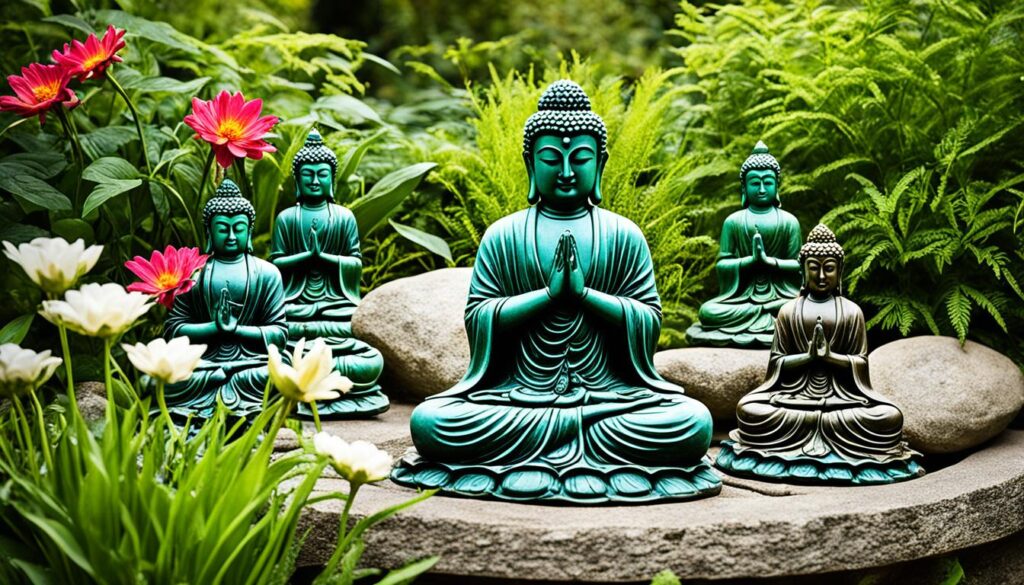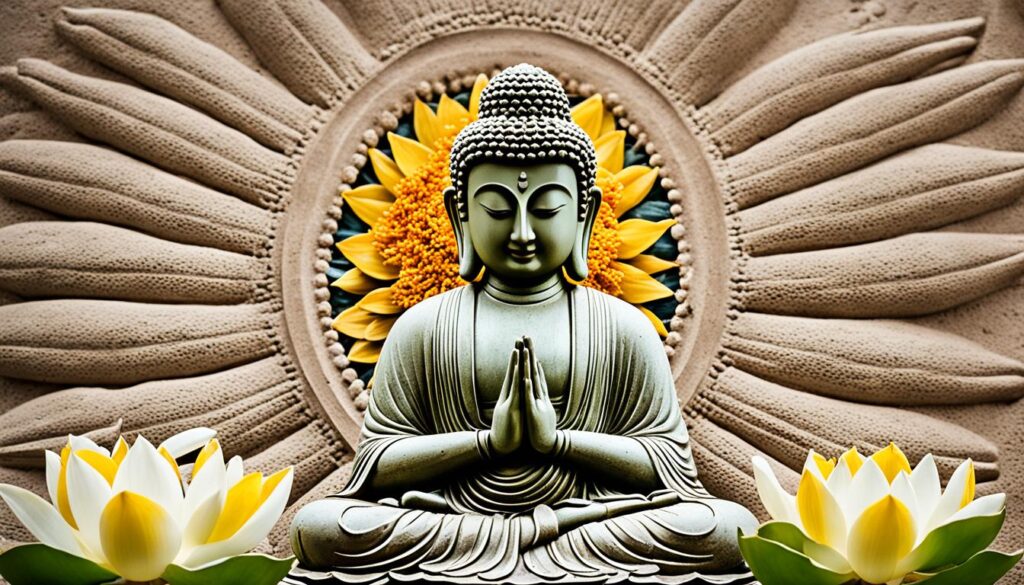“The mind is everything. What you think you become.” – Buddha
Welcome to a journey of tranquility and self-discovery as we delve into the fascinating world of Buddhism. This ancient and profound religion offers timeless wisdom and transformative teachings that can guide us towards inner peace and enlightenment.
Buddhism is not merely a belief system; it is a way of life that emphasizes the importance of self-reflection, compassion, and a deep understanding of the nature of existence. With over 376 million followers worldwide, Buddhism has captured the hearts and minds of people from diverse cultures and backgrounds.
In this article, we will uncover the facts about Buddhism, including its core beliefs and principles, the symbolism of Buddha statues, the types of Buddha statues, the materials used in their creation, and the evolution of these statues over time. We will also explore the profound concept of Buddha-Nature and its significance in Buddhist practice and philosophy.
Join us on this enlightening journey as we discover the serenity and wisdom that Buddhism has to offer.
Key Takeaways:
- Buddhism emphasizes mindfulness, compassion, and personal transformation.
- Buddha statues embody deep symbolism and serve as reminders of the Buddha’s teachings.
- There are various types of Buddha statues, each with their own unique characteristics and symbolism.
- Buddha statues are crafted using different materials, each carrying its own significance.
- Over time, Buddha statues have evolved, reflecting the cultural and artistic advancements of different regions.
The Symbolism of Buddha Statues
Buddha statues hold deep spiritual significance in Buddhism. They go beyond being mere decorative items and serve as powerful reminders of the Buddha’s teachings and the path to enlightenment. Each element of a Buddha statue, from the posture to the hand gestures and facial expressions, carries profound symbolism.
The seated or meditating posture represents the Buddha’s own meditation and emphasizes the importance of a calm and focused mind. The hand gestures, called mudras, convey different aspects of the Buddha’s teachings and states of mind. The serene facial expression represents inner peace and wisdom.
Additionally, Buddha statues are often adorned with symbolic elements:
- The lotus symbolizes purity and enlightenment.
- The robe represents the renunciation of worldly possessions and simplicity.
- The urn represents the preservation of the Buddha’s relics.
- The third eye symbolizes heightened spiritual awareness and insight.
- The wheel represents the teachings of the Dharma and the cycle of life.
The combination of these elements enriches the meaning of Buddha statues and provides practitioners with visual representations of the Buddha’s enlightened state and teachings.
Types of Buddha Statues
When it comes to Buddha statues, there is a diverse array of types, each imbued with its own unique characteristics and symbolism. These statues serve as powerful visual representations of the Buddha’s teachings, inspiring practitioners on their spiritual journey. Let’s explore some of the common types of Buddha statues and their significance:
Meditating Buddha Statue

The meditating Buddha statue is a symbol of inner peace and mindfulness. It depicts the Buddha in a seated meditation posture, with crossed legs and hands resting on the lap or in a mudra. This statue reminds us of the importance of cultivating a calm and focused mind, enabling us to connect with our inner selves and attain a state of tranquility.
Laughing Buddha Statue

The laughing Buddha statue, also known as the “Budai” or “Hotei,” represents good luck, happiness, and abundance. This jovial figure is often portrayed as a plump, bald monk with a big smile and a bag of treasures. The presence of a laughing Buddha statue is believed to bring joy, prosperity, and contentment into one’s life.
Reclining Buddha Statue

The reclining Buddha statue depicts the Buddha lying down on his right side, with his head supported by his hand. This posture symbolizes the impermanence of life and the ultimate goal of spiritual liberation. It serves as a reminder to embrace the transitory nature of existence and strive for enlightenment, seeking liberation from suffering.
Standing Buddha Statue

The standing Buddha statue represents courage, compassion, and the readiness to help others. It depicts the Buddha standing tall with one hand raised in a gesture of fearlessness and the other hand in a gesture of compassion. This statue inspires us to cultivate strength and kindness in our lives, extending a helping hand to those in need.
Comparison of Symbolism in Different Types of Buddha Statues
| Buddha Statue | Symbolism |
|---|---|
| Meditating Buddha Statue | Inner peace and mindfulness |
| Laughing Buddha Statue | Good luck and happiness |
| Reclining Buddha Statue | Impermanence of life and spiritual liberation |
| Standing Buddha Statue | Courage, compassion, and readiness to help others |
Materials Used in Buddha Statues
Buddha statues are crafted using various materials, each with its own unique symbolism and significance. The choice of material not only contributes to the visual appeal of the statues but also enhances the spiritual experience they evoke. Let’s explore some of the materials commonly used in the creation of Buddha statues and the meaning they convey:
1. Stone
Stone, such as marble and granite, is often used to create Buddha statues. Stone represents durability and timelessness, symbolizing the enduring nature of the Buddha’s teachings. The solid and unyielding nature of stone reflects the steadfastness and strength required to attain enlightenment.
2. Wood
Wood, such as teak and sandalwood, is another popular material for crafting Buddha statues. Wood embodies the beauty of nature and signifies the impermanence of life. Just as wood weathers and changes over time, our lives too are subject to constant transformation.
3. Bronze and Brass
Bronze and brass are metals commonly used in the creation of Buddha statues. These metals symbolize strength, wisdom, and the radiant teachings of the Buddha. The lustrous appearance of bronze and brass reflects the enlightening qualities that practitioners seek to cultivate on their spiritual journey.
4. Precious Gemstones
Precious gemstones, such as jade and amethyst, are sometimes incorporated into Buddha statues. These gemstones add a touch of opulence and imbue the statues with spiritual significance. Jade, for example, is associated with wisdom and purity, while amethyst is believed to promote spiritual growth and insight.
Each material used in the creation of Buddha statues carries its own symbolism, contributing to the overall message and impact of the artwork. The use of stones, wood, metals, or gemstones allows artists to infuse their sculptures with deeper meaning, creating a powerful symbol of the Buddha’s teachings and the path to enlightenment.

| Material | Symbolism |
|---|---|
| Stone (marble, granite) | Durability, timelessness, steadfastness |
| Wood (teak, sandalwood) | Nature’s beauty, impermanence of life |
| Bronze, Brass | Strength, wisdom, radiant teachings |
| Precious Gemstones (jade, amethyst) | Opulence, spiritual significance |
The Evolution of Buddha Statues Over Time
Buddha statues have undergone a remarkable evolution throughout history, reflecting the cultural and artistic advancements of different regions. In the early period of Buddhism, statues were created with simplicity and stylization, aiming to capture the essence of the Buddha’s teachings and spiritual presence. These statues, with their clean and minimalistic designs, emphasized the core principles of Buddhism and served as powerful objects of contemplation and inspiration.
As Buddhism spread to various countries, local artists began to incorporate intricate details and lifelike expressions into their statues. These developments allowed for a more realistic portrayal of the Buddha, enabling practitioners to connect on a deeper level with his teachings. The evolution of style and technique brought about a profound sense of reverence and devotion, as every detail became a manifestation of the Buddha’s wisdom and compassion.
Contemporary interpretations of Buddha statues have also emerged, blending traditional elements with modern influences. These statues often showcase a harmonious blend of cultural aesthetics, reflecting the global nature of Buddhism and its adaptability. Artists have experimented with different materials, colors, and forms, creating statues that resonate with diverse audiences and contemporary sensibilities.
The evolution of Buddha statues is not merely a reflection of artistic expression. It also signifies the continuous growth and development of Buddhism as a spiritual and cultural tradition. Each iteration of a Buddha statue represents the evolving understanding and interpretation of the teachings, ensuring that Buddhism remains relevant and accessible to people in different eras and cultural contexts.
The Concept of Buddha-Nature
Buddha-Nature is a profound cornerstone within Mahayana Buddhism, asserting that every sentient being possesses the potential to attain enlightenment and become a Buddha. It is compared to a dormant seed that can germinate and flourish under the right conditions.
Buddha-Nature is universally embracing, extending beyond a select few and residing within all sentient beings. It emphasizes that individuals have the potential to cultivate wisdom, compassion, and liberation from selfishness. Buddha-Nature is often associated with the luminous nature of the mind and is a transformative perspective that motivates individuals on their spiritual journey.
The Inherent Potential for Enlightenment
In the concept of Buddha-Nature, the true nature of all beings is considered to be inherently enlightened. It is the spark within each individual that holds the seeds of wisdom, compassion, and awakening. The analogy of a dormant seed reminds us that anyone can unlock their innate potential and blossom into a fully enlightened being.
By recognizing the Buddha-Nature within ourselves and others, we acknowledge the divine spark that connects us all. It is a reminder that no matter our circumstances or current state of being, we possess the potential for profound spiritual growth and realization.
Cultivating Wisdom, Compassion, and Liberation
The recognition of Buddha-Nature inspires practitioners to embark on a journey of self-discovery and self-transformation. It motivates us to cultivate wisdom, compassion, and liberation from selfishness.
- Wisdom: By studying the Buddha’s teachings and practicing mindfulness, individuals can develop insight into the nature of reality, recognizing the impermanence and interconnectedness of all phenomena. Wisdom allows us to see through the illusions of ego and desire, leading to a deeper understanding of ourselves and the world.
- Compassion: Buddha-Nature teaches us to nurture a genuine sense of empathy and love for all beings. By recognizing the inherent dignity and worth of every sentient being, we cultivate compassion and strive to alleviate the suffering of others. Compassion is not limited to those we find agreeable; it extends to all beings, including ourselves.
- Liberation: Buddha-Nature awakens us to the possibility of liberation from the cycle of suffering and rebirth. By realizing our inherent potential for enlightenment, we can free ourselves from the attachments and delusions that bind us. Liberation is the ultimate goal of the spiritual journey, leading to a state of lasting peace, wisdom, and liberation from the cycle of birth and death.

| Key Points | Essence of Buddha-Nature |
|---|---|
| 1 | Buddha-Nature asserts that every sentient being possesses the potential to attain enlightenment and become a Buddha. |
| 2 | It is like a dormant seed that can germinate and flourish under the right conditions. |
| 3 | Buddha-Nature is universally embracing and resides within all sentient beings. |
| 4 | It emphasizes the cultivation of wisdom, compassion, and liberation from selfishness. |
| 5 | Buddha-Nature is associated with the luminous nature of the mind and motivates individuals on their spiritual journey. |
The Significance of Buddha-Nature in Buddhist Practice and Philosophy
Buddha-Nature holds profound significance in Buddhist practice and philosophy, serving as a transformative concept that motivates individuals on their spiritual journey. It offers a motivational influence, instilling hope, determination, and a clear sense of purpose. Buddha-Nature emphasizes the immense significance of compassion and altruism, reminding practitioners that all beings possess the potential for enlightenment.
This concept challenges restrictive beliefs and self-worth judgments, promoting self-acceptance and fostering motivation for spiritual growth. It encompasses qualities such as purity, selfless compassion, and the ability to embrace both pleasure and pain. Buddha-Nature calls upon individuals to embark on a journey of self-realization, recognizing their inherent potential for awakening and transformation.
By embracing the concept of Buddha-Nature, practitioners are inspired to cultivate wisdom, compassion, and liberation from selfishness. It fosters a deep sense of interconnectedness and encourages the development of a compassionate and caring society.
Conclusion
Buddhism, with its profound teachings and emphasis on mindfulness, compassion, and personal cultivation, offers invaluable wisdom for personal growth and societal harmony. The symbolism embedded within Buddha statues serves as a poignant reminder of the Buddha’s teachings, inspiring individuals to strive for inner peace and wisdom.
The concept of Buddha-Nature illuminates the inherent potential for enlightenment within all beings, fostering motivation for spiritual practice and self-realization. Buddhism continues to capture the hearts and minds of millions worldwide, providing a transformative path towards enlightenment and liberation from suffering.
By embracing the principles of Buddhism, you can embark on a journey of self-discovery, cultivate compassion for yourself and others, and find solace in the pursuit of wisdom and enlightenment. Let the timeless teachings of Buddhism guide you towards a life of serenity, compassion, and spiritual fulfillment.
FAQ
What are the beliefs of Buddhism?
Buddhism emphasizes wisdom, compassion, and personal transformation. It teaches the impermanence of life and the possibility of attaining nirvana, a state of liberation from suffering.
How many people follow Buddhism globally?
Buddhism has a global following of over 376 million people and is practiced in various forms and traditions across the world.
What is the significance of Buddha statues?
Buddha statues serve as powerful reminders of the Buddha’s teachings and the path to enlightenment. Each element of a Buddha statue carries profound symbolism, representing aspects such as meditation, teachings, and inner peace.
What are the different types of Buddha statues and their symbolism?
There are various types of Buddha statues, each with its own unique symbolism. The meditating Buddha represents inner peace and mindfulness, the laughing Buddha symbolizes good luck and happiness, the reclining Buddha signifies the impermanence of life, and the standing Buddha symbolizes courage and compassion.
What materials are used in crafting Buddha statues?
Buddha statues are crafted using various materials, each with its own significance. Stone represents durability, wood reflects the impermanence of life, bronze and brass symbolize strength and wisdom, and precious gemstones add spiritual significance.
How have Buddha statues evolved over time?
Buddha statues have evolved, reflecting the cultural and artistic advancements of different regions. They started as simple and stylized representations and later incorporated intricate details and lifelike expressions. Contemporary interpretations also emerged, incorporating modern materials and cultural influences.
What is Buddha-Nature?
Buddha-Nature is a cornerstone within Mahayana Buddhism, asserting that every sentient being possesses the potential to attain enlightenment and become a Buddha. It emphasizes the cultivation of wisdom, compassion, and liberation from selfishness.
What is the significance of Buddha-Nature in Buddhist practice?
Buddha-Nature serves as a motivational influence, instilling hope, determination, and a clear sense of purpose. It promotes compassion, challenges restrictive beliefs, and encourages individuals to recognize their inherent potential for awakening and transformation.
What wisdom and teachings does Buddhism offer?
Buddhism offers timeless wisdom and transformative teachings, emphasizing mindfulness, compassion, and personal cultivation. It provides insights for personal and societal harmony, offering a path towards enlightenment and liberation from suffering.
What are the key points to remember about Buddhism?
Buddhism is a profound and inspiring religion with a rich history and principles. It focuses on wisdom, compassion, and personal transformation, teaches the impermanence of life, and offers a path towards nirvana. Buddha statues serve as reminders of the Buddha’s teachings, and the concept of Buddha-Nature highlights the inherent potential for enlightenment within all beings.

